Select your language
Suggested languages for you:
Lerne mit deinen Freunden und bleibe auf dem richtigen Kurs mit deinen persönlichen Lernstatistiken
Jetzt kostenlos anmelden

Words don’t only mean something; they also do something. In the English language, words are grouped into word classes based on their function, i.e. what they do in a phrase or sentence. In total, there are nine word classes in English.
Word class meaning and example
All words can be categorised into classes within a language based on their function and purpose.
An example of various word classes is ‘The cat ate a cupcake quickly.’
-
The = a determiner
-
cat = a noun
-
ate = a verb
-
a = determiner
-
cupcake = noun
-
quickly = an adverb
Word class function
The function of a word class, also known as a part of speech, is to classify words according to their grammatical properties and the roles they play in sentences. By assigning words to different word classes, we can understand how they should be used in context and how they relate to other words in a sentence.
Each word class has its own unique set of characteristics and rules for usage, and understanding the function of word classes is essential for effective communication in English. Knowing our word classes allows us to create clear and grammatically correct sentences that convey our intended meaning.
Word classes in English
In English, there are four main word classes; nouns, verbs, adjectives, and adverbs. These are considered lexical words, and they provide the main meaning of a phrase or sentence.
The other five word classes are; prepositions, pronouns, determiners, conjunctions, and interjections. These are considered functional words, and they provide structural and relational information in a sentence or phrase.
Don’t worry if it sounds a bit confusing right now. Read ahead and you’ll be a master of the different types of word classes in no time!
| All word classes | Definition | Examples of word classification |
| Noun | A word that represents a person, place, thing, or idea. | cat, house, plant |
| Pronoun | A word that is used in place of a noun to avoid repetition. | he, she, they, it |
| Verb | A word that expresses action, occurrence, or state of being. | run, sing, grow |
| Adjective | A word that describes or modifies a noun or pronoun. | blue, tall, happy |
| Adverb | A word that describes or modifies a verb, adjective, or other adverb. | quickly, very |
| Preposition | A word that shows the relationship between a noun or pronoun and other words in a sentence. | in, on, at |
| Conjunction | A word that connects words, phrases, or clauses. | and, or, but |
| Interjection | A word that expresses strong emotions or feelings. | wow, oh, ouch |
| Determiners | A word that clarifies information about the quantity, location, or ownership of the noun | Articles like ‘the’ and ‘an’, and quantifiers like ‘some’ and ‘all’. |
The four main word classes
In the English language, there are four main word classes: nouns, verbs, adjectives, and adverbs. Let’s look at all the word classes in detail.
Nouns
Nouns are the words we use to describe people, places, objects, feelings, concepts, etc. Usually, nouns are tangible (touchable) things, such as a table, a person, or a building.
However, we also have abstract nouns, which are things we can feel and describe but can’t necessarily see or touch, such as love, honour, or excitement. Proper nouns are the names we give to specific and official people, places, or things, such as England, Claire, or Hoover.
Cat
House
School
Britain
Harry
Book
Hatred
‘My sister went to school.‘
Verbs
Verbs are words that show action, event, feeling, or state of being. This can be a physical action or event, or it can be a feeling that is experienced.
Lexical verbs are considered one of the four main word classes, and auxiliary verbs are not. Lexical verbs are the main verb in a sentence that shows action, event, feeling, or state of being, such as walk, ran, felt, and want, whereas an auxiliary verb helps the main verb and expresses grammatical meaning, such as has, is, and do.
Run
Walk
Swim
Curse
Wish
Help
Leave
‘She wished for a sunny day.’
Adjectives
Adjectives are words used to modify nouns, usually by describing them. Adjectives describe an attribute, quality, or state of being of the noun.
Long
Short
Friendly
Broken
Loud
Embarrassed
Dull
Boring
‘The friendly woman wore a beautiful dress.’

Adverbs
Adverbs are words that work alongside verbs, adjectives, and other adverbs. They provide further descriptions of how, where, when, and how often something is done.
Quickly
Softly
Very
More
Too
Loudly
‘The music was too loud.’
All of the above examples are lexical word classes and carry most of the meaning in a sentence. They make up the majority of the words in the English language.
The other five word classes
The other five remaining word classes are; prepositions, pronouns, determiners, conjunctions, and interjections. These words are considered functional words and are used to explain grammatical and structural relationships between words.
For example, prepositions can be used to explain where one object is in relation to another.
Prepositions
Prepositions are used to show the relationship between words in terms of place, time, direction, and agency.
In
At
On
Towards
To
Through
Into
By
With
‘They went through the tunnel.’
Pronouns
Pronouns take the place of a noun or a noun phrase in a sentence. They often refer to a noun that has already been mentioned and are commonly used to avoid repetition.
Chloe (noun) → she (pronoun)
Chloe’s dog → her dog (possessive pronoun)
There are several different types of pronouns; let’s look at some examples of each.
- He, she, it, they — personal pronouns
- His, hers, its, theirs, mine, ours — possessive pronouns
- Himself, herself, myself, ourselves, themselves — reflexive pronouns
- This, that, those, these — demonstrative pronouns
- Anyone, somebody, everyone, anything, something — Indefinite pronouns
- Which, what, that, who, who — Relative pronouns
‘She sat on the chair which was broken.’
Determiners
Determiners work alongside nouns to clarify information about the quantity, location, or ownership of the noun. It ‘determines’ exactly what is being referred to. Much like pronouns, there are also several different types of determiners.
- The, a, an — articles
- This, that, those — you might recognise these for demonstrative pronouns are also determiners
- One, two, three etc. — cardinal numbers
- First, second, third etc. — ordinal numbers
- Some, most, all — quantifiers
- Other, another — difference words
‘The first restaurant is better than the other.’
Conjunctions
Conjunctions are words that connect other words, phrases, and clauses together within a sentence. There are three main types of conjunctions;
-
Coordinating conjunctions — these link independent clauses together.
-
Subordinating conjunctions — these link dependent clauses to independent clauses.
- Correlative conjunctions — words that work in pairs to join two parts of a sentence of equal importance.
For, and, nor, but, or, yet, so — coordinating conjunctions
After, as, because, when, while, before, if, even though — subordinating conjunctions
Either/or, neither/nor, both/and — correlative conjunctions
‘If it rains, I’m not going out.’
Interjections
Interjections are exclamatory words used to express an emotion or a reaction. They often stand alone from the rest of the sentence and are accompanied by an exclamation mark.
Oh
Oops!
Phew!
Ahh!
‘Oh, what a surprise!’
Word class: lexical classes and function classes
A helpful way to understand lexical word classes is to see them as the building blocks of sentences. If the lexical word classes are the blocks themselves, then the function word classes are the cement holding the words together and giving structure to the sentence.

In this diagram, the lexical classes are in blue and the function classes are in yellow. We can see that the words in blue provide the key information, and the words in yellow bring this information together in a structured way.
Word class examples
Sometimes it can be tricky to know exactly which word class a word belongs to. Some words can function as more than one word class depending on how they are used in a sentence. For this reason, we must look at words in context, i.e. how a word works within the sentence. Take a look at the following examples of word classes to see the importance of word class categorisation.
The dog will bark if you open the door.
The tree bark was dark and rugged.
Here we can see that the same word (bark) has a different meaning and different word class in each sentence. In the first example, ‘bark’ is used as a verb, and in the second as a noun (an object in this case).
I left my sunglasses on the beach.
The horse stood on Sarah’s left foot.
In the first sentence, the word ‘left’ is used as a verb (an action), and in the second, it is used to modify the noun (foot). In this case, it is an adjective.
I run every day
I went for a run
In this example, ‘run’ can be a verb or a noun.
Word Class — Key takeaways
-
We group words into word classes based on the function they perform in a sentence.
-
The four main word classes are nouns, adjectives, verbs, and adverbs. These are lexical classes that give meaning to a sentence.
-
The other five word classes are prepositions, pronouns, determiners, conjunctions, and interjections. These are function classes that are used to explain grammatical and structural relationships between words.
-
It is important to look at the context of a sentence in order to work out which word class a word belongs to.
Frequently Asked Questions about Word Class
A word class is a group of words that have similar properties and play a similar role in a sentence.
Some examples of how some words can function as more than one word class include the way ‘run’ can be a verb (‘I run every day’) or a noun (‘I went for a run’). Similarly, ‘well’ can be an adverb (‘He plays the guitar well’) or an adjective (‘She’s feeling well today’).
The nine word classes are; Nouns, adjectives, verbs, adverbs, prepositions, pronouns, determiners, conjunctions, interjections.
Categorising words into word classes helps us to understand the function the word is playing within a sentence.
Parts of speech is another term for word classes.
The different groups of word classes include lexical classes that act as the building blocks of a sentence e.g. nouns. The other word classes are function classes that act as the ‘glue’ and give grammatical information in a sentence e.g. prepositions.
The word classes for all, that, and the is:
‘All’ = determiner (quantifier)
‘That’ = pronoun and/or determiner (demonstrative pronoun)
‘The’ = determiner (article)
Final Word Class Quiz
Word Class Quiz — Teste dein Wissen
Question
A word can only belong to one type of noun. True or false?
Show answer
Answer
This is false. A word can belong to multiple categories of nouns and this may change according to the context of the word.
Show question
Question
Name the two principal categories of nouns.
Show answer
Answer
The two principal types of nouns are ‘common nouns’ and ‘proper nouns’.
Show question
Question
Which of the following is an example of a proper noun?
Show answer
Question
Name the 6 types of common nouns discussed in the text.
Show answer
Answer
Concrete nouns, abstract nouns, countable nouns, uncountable nouns, collective nouns, and compound nouns.
Show question
Question
What is the difference between a concrete noun and an abstract noun?
Show answer
Answer
A concrete noun is a thing that physically exists. We can usually touch this thing and measure its proportions. An abstract noun, however, does not physically exist. It is a concept, idea, or feeling that only exists within the mind.
Show question
Question
Pick out the concrete noun from the following:
Show answer
Question
Pick out the abstract noun from the following:
Show answer
Question
What is the difference between a countable and an uncountable noun? Can you think of an example for each?
Show answer
Answer
A countable noun is a thing that can be ‘counted’, i.e. it can exist in the plural. Some examples include ‘bottle’, ‘dog’ and ‘boy’. These are often concrete nouns.
An uncountable noun is something that can not be counted, so you often cannot place a number in front of it. Examples include ‘love’, ‘joy’, and ‘milk’.
Show question
Question
Pick out the collective noun from the following:
Show answer
Question
What is the collective noun for a group of sheep?
Show answer
Answer
The collective noun is a ‘flock’, as in ‘flock of sheep’.
Show question
Question
The word ‘greenhouse’ is a compound noun. True or false?
Show answer
Answer
This is true. The word ‘greenhouse’ is a compound noun as it is made up of two separate words ‘green’ and ‘house’. These come together to form a new word.
Show question
Question
What are the adjectives in this sentence?: ‘The little boy climbed up the big, green tree’
Show answer
Answer
The adjectives are ‘little’ and ‘big’, and ‘green’ as they describe features about the nouns.
Show question
Question
Place the adjectives in this sentence into the correct order: the wooden blue big ship sailed across the Indian vast scary ocean.
Show answer
Answer
The big, blue, wooden ship sailed across the vast, scary, Indian ocean.
Show question
Question
What are the 3 different positions in which an adjective can be placed?
Show answer
Answer
An adjective can be placed before a noun (pre-modification), after a noun (post-modification), or following a verb as a complement.
Show question
Question
In this sentence, does the adjective pre-modify or post-modify the noun? ‘The unicorn is angry’.
Show answer
Answer
The adjective ‘angry’ post-modifies the noun ‘unicorn’.
Show question
Question
In this sentence, does the adjective pre-modify or post-modify the noun? ‘It is a scary unicorn’.
Show answer
Answer
The adjective ‘scary’ pre-modifies the noun ‘unicorn’.
Show question
Question
What kind of adjectives are ‘purple’ and ‘shiny’?
Show answer
Answer
‘Purple’ and ‘Shiny’ are qualitative adjectives as they describe a quality or feature of a noun
Show question
Question
What kind of adjectives are ‘ugly’ and ‘easy’?
Show answer
Answer
The words ‘ugly’ and ‘easy’ are evaluative adjectives as they give a subjective opinion on the noun.
Show question
Question
Which of the following adjectives is an absolute adjective?
Show answer
Question
Which of these adjectives is a classifying adjective?
Show answer
Question
Convert the noun ‘quick’ to its comparative form.
Show answer
Answer
The comparative form of ‘quick’ is ‘quicker’.
Show question
Question
Convert the noun ‘slow’ to its superlative form.
Show answer
Answer
The comparative form of ‘slow’ is ‘slowest’.
Show question
Question
What is an adjective phrase?
Show answer
Answer
An adjective phrase is a group of words that is ‘built’ around the adjective (it takes centre stage in the sentence). For example, in the phrase ‘the dog is big’ the word ‘big’ is the most important information.
Show question
Question
Give 2 examples of suffixes that are typical of adjectives.
Show answer
Answer
Suffixes typical of adjectives include -able, -ible, -ful, -y, -less, -ous, -some, -ive, -ish, -al.
Show question
Question
What is the difference between a main verb and an auxiliary verb?
Show answer
Answer
A main verb is a verb that can stand on its own and carries most of the meaning in a verb phrase. For example, ‘run’, ‘find’. Auxiliary verbs cannot stand alone, instead, they work alongside a main verb and ‘help’ the verb to express more grammatical information e.g. tense, mood, possibility.
Show question
Question
What is the difference between a primary auxiliary verb and a modal auxiliary verb?
Show answer
Answer
Primary auxiliary verbs consist of the various forms of ‘to have’, ‘to be’, and ‘to do’ e.g. ‘had’, ‘was’, ‘done’. They help to express a verb’s tense, voice, or mood. Modal auxiliary verbs show possibility, ability, permission, or obligation. There are 9 auxiliary verbs including ‘could’, ‘will’, might’.
Show question
Question
Which of the following are primary auxiliary verbs?
-
Is
-
Play
-
Have
-
Run
-
Does
-
Could
Show answer
Answer
The primary auxiliary verbs in this list are ‘is’, ‘have’, and ‘does’. They are all forms of the main primary auxiliary verbs ‘to have’, ‘to be’, and ‘to do’. ‘Play’ and ‘run’ are main verbs and ‘could’ is a modal auxiliary verb.
Show question
Question
Name 6 out of the 9 modal auxiliary verbs.
Show answer
Answer
Answers include: Could, would, should, may, might, can, will, must, shall
Show question
Question
‘The fairies were asleep’. In this sentence, is the verb ‘were’ a linking verb or an auxiliary verb?
Show answer
Answer
The word ‘were’ is used as a linking verb as it stands alone in the sentence. It is used to link the subject (fairies) and the adjective (asleep).
Show question
Question
What is the difference between dynamic verbs and stative verbs?
Show answer
Answer
A dynamic verb describes an action or process done by a noun or subject. They are thought of as ‘action verbs’ e.g. ‘kick’, ‘run’, ‘eat’. Stative verbs describe the state of being of a person or thing. These are states that are not necessarily physical action e.g. ‘know’, ‘love’, ‘suppose’.
Show question
Question
Which of the following are dynamic verbs and which are stative verbs?
-
Drink
-
Prefer
-
Talk
-
Seem
-
Understand
-
Write
Show answer
Answer
The dynamic verbs are ‘drink’, ‘talk’, and ‘write’ as they all describe an action. The stative verbs are ‘prefer’, ‘seem’, and ‘understand’ as they all describe a state of being.
Show question
Question
What is an imperative verb?
Show answer
Answer
Imperative verbs are verbs used to give orders, give instructions, make a request or give warning. They tell someone to do something. For example, ‘clean your room!’.
Show question
Question
Inflections give information about tense, person, number, mood, or voice. True or false?
Show answer
Question
What information does the inflection ‘-ing’ give for a verb?
Show answer
Answer
The inflection ‘-ing’ is often used to show that an action or state is continuous and ongoing.
Show question
Question
How do you know if a verb is irregular?
Show answer
Answer
An irregular verb does not take the regular inflections, instead the whole word is spelt a different way. For example, begin becomes ‘began’ or ‘begun’. We can’t add the regular past tense inflection -ed as this would become ‘beginned’ which doesn’t make sense.
Show question
Question
Suffixes can never signal what word class a word belongs to. True or false?
Show answer
Answer
False. Suffixes can signal what word class a word belongs to. For example, ‘-ify’ is a common suffix for verbs (‘identity’, ‘simplify’)
Show question
Question
A verb phrase is built around a noun. True or false?
Show answer
Answer
False. A verb phrase is a group of words that has a main verb along with any other auxiliary verbs that ‘help’ the main verb. For example, ‘could eat’ is a verb phrase as it contains a main verb (‘could’) and an auxiliary verb (‘could’).
Show question
Question
Which of the following are multi-word verbs?
-
Shake
-
Rely on
-
Dancing
-
Look up to
Show answer
Answer
The verbs ‘rely on’ and ‘look up to’ are multi-word verbs as they consist of a verb that has one or more prepositions or particles linked to it.
Show question
Question
What is the difference between a transition verb and an intransitive verb?
Show answer
Answer
Transitive verbs are verbs that require an object in order to make sense. For example, the word ‘bring’ requires an object that is brought (‘I bring news’). Intransitive verbs do not require an object to complete the meaning of the sentence e.g. ‘exist’ (‘I exist’).
Show question
Answer
An adverb is a word that gives more information about a verb, adjective, another adverb, or a full clause.
Show question
Question
What are the 3 ways we can use adverbs?
Show answer
Answer
We can use adverbs to modify a word (modifying adverbs), to intensify a word (intensifying adverbs), or to connect two clauses (connecting adverbs).
Show question
Question
What are modifying adverbs?
Show answer
Answer
Modifying adverbs are words that modify verbs, adjectives, or other adverbs. They add further information about the word.
Show question
Question
‘Additionally’, ‘likewise’, and ‘consequently’ are examples of connecting adverbs. True or false?
Show answer
Answer
True! Connecting adverbs are words used to connect two independent clauses.
Show question
Question
What are intensifying adverbs?
Show answer
Answer
Intensifying adverbs are words used to strengthen the meaning of an adjective, another adverb, or a verb. In other words, they ‘intensify’ another word.
Show question
Question
Which of the following are intensifying adverbs?
-
Calmly
-
Incredibly
-
Enough
-
Greatly
Show answer
Answer
The intensifying adverbs are ‘incredibly’ and ‘greatly’. These strengthen the meaning of a word.
Show question
Question
Name the main types of adverbs
Show answer
Answer
The main adverbs are; adverbs of place, adverbs of time, adverbs of manner, adverbs of frequency, adverbs of degree, adverbs of probability, and adverbs of purpose.
Show question
Question
What are adverbs of time?
Show answer
Answer
Adverbs of time are the ‘when?’ adverbs. They answer the question ‘when is the action done?’ e.g. ‘I’ll do it tomorrow’
Show question
Question
Which of the following are adverbs of frequency?
-
Usually
-
Patiently
-
Occasionally
-
Nowhere
Show answer
Answer
The adverbs of frequency are ‘usually’ and ‘occasionally’. They are the ‘how often?’ adverbs. They answer the question ‘how often is the action done?’.
Show question
Question
What are adverbs of place?
Show answer
Answer
Adverbs of place are the ‘where?’ adverbs. They answer the question ‘where is the action done?’. For example, ‘outside’ or ‘elsewhere’.
Show question
Question
Which of the following are adverbs of manner?
-
Never
-
Carelessly
-
Kindly
-
Inside
Show answer
Answer
The words ‘carelessly’ and ‘kindly’ are adverbs of manner. They are the ‘how?’ adverbs that answer the question ‘how is the action done?’.
Show question
Discover the right content for your subjects
No need to cheat if you have everything you need to succeed! Packed into one app!
Study Plan
Be perfectly prepared on time with an individual plan.
Quizzes
Test your knowledge with gamified quizzes.
Flashcards
Create and find flashcards in record time.
Notes
Create beautiful notes faster than ever before.
Study Sets
Have all your study materials in one place.
Documents
Upload unlimited documents and save them online.
Study Analytics
Identify your study strength and weaknesses.
Weekly Goals
Set individual study goals and earn points reaching them.
Smart Reminders
Stop procrastinating with our study reminders.
Rewards
Earn points, unlock badges and level up while studying.
Magic Marker
Create flashcards in notes completely automatically.
Smart Formatting
Create the most beautiful study materials using our templates.
Sign up to highlight and take notes. It’s 100% free.
This website uses cookies to improve your experience. We’ll assume you’re ok with this, but you can opt-out if you wish. Accept
Privacy & Cookies Policy
Every word in a sentence plays a different role, refer as the parts of speech. There are the following word classes in english grammar. Word Classes are very important part in grammar. They decide different rules of grammar. More precisely every grammar rule comes out of them. They are the most basic part of a sentences. Without word classes English language would never be possible and that why these 9 words classes are the base of English language.
9 Words Classes in English Grammar
There are following word classes in English grammar.
1. Nouns
A noun is the name of a person, place, concept, or object, like Marry, John, Canada, Japan, truth, honesty, table and, knife Etc. Nouns occupy the major part of English compositions and come in a wide variety of types. They are used as the subject, direct object, indirect objects, plurals, possessive nouns, opposites and adjectives. Mostly nouns are divided into two categories: common nouns and proper nouns.
Examples:
- Cat was under the table.
- Sarah comes out of no where.
- This purse does not belongs to my father.
- Mosque was very beautiful.
List of Some Nouns:
| Banana | Quill | Hospital |
| Car | School | Juice |
| Dinner | Tent | Lizard |
| Engine | Vulture | Morning |
| France | Girl | Oxygen |
| Ambulance | Pillow | Hair |
| Belgium | Restaurant | Insurance |
| Church | Spoon | Knife |
| Dress | Train | Magazine |
| Finland | Xylophone | Nest |
| Airport | Piano | Guitar |
| Bed | Refrigerator | Insect |
| China | Soccer | Kite |
i. Common Noun Vs. Proper Noun
Common nouns
They refer the general things, like books and football.
Proper nouns
They deal with the specific names, like David and London.
ii. Countable Nouns Vs. Uncountable Nouns
Countable Nouns
Nouns which we can count like cats, books, pens Etc.
Uncountable Nouns
Nouns that we cannot count like liquid, air, intelligence.
2. Pronouns
Pronouns are the words that substitute for nouns. For example, he, she, it, her, his you, many, who, everybody Etc. Pronouns are divided into a range of categories. personal pronoun, possessive pronoun, relative pronoun, reflexive pronoun, indefinite pronoun, demonstrative pronoun, an interrogative pronoun, intensive pronoun and reciprocal pronoun.
Examples:
- Tom was going to Mosque, and I just followed him.
- Tina is the friend of Sara, and I am their class fellow.
- He is the man of a lot of sugar in his juice.
Some Pronouns are:
| he | her | hers |
| him | his | I |
| it | its | our |
| she | theirs | them |
| they | us | we |
| you | your |
3. Adjectives
Adjectives describe the qualities or states of nouns. Adjectives are fast, funny, engaging, well-written. There are three degrees of adjectives positive, comparative and superlative adjectives black. They also describe the quality of nouns, many, few, millions Etc.
Examples
- Tom is a brave boy and that’s why he is in at Army.
- My brother is a good looking actor in Germany.
- Shimla is a coward lady of our society.
Here are some common adjectives:
| dull | drab | doubtful |
| dizzy | disturbed | distinct |
| disgusted | difficult | different |
| determined | depressed | delightful |
| defiant | defeated | dead |
| dark | dangerous | cute |
| curious | cruel | crowded |
| creepy | crazy | courageous |
| cooperative | confused | condemned |
| concerned | comfortable | combative |
| colorful | clumsy | cloudy |
| clever | clear | clean |
| cheerful | charming | cautious |
| careful | calm | busy |
| bright | breakable | brave |
| brainy | bored | blushing |
| blue-eyed | blue | bloody |
| black | bewildered | better |
| beautiful | bad | awful |
| average | attractive | ashamed |
| arrogant | anxious | annoying |
| annoyed | angry | amused |
| alive | alert | agreeable |
| aggressive | adventurous | adorable |
4. Verbs
Verbs describe specific actions, like running, winning, and amazing. There are six types of verbs.
Examples:
- Tina was playing cricket.
- Roma is eating bread with butter.
i. Action verbs
They describe action words a person or thing can do such as accept, ask, bake Etc.
Below are some common action verbs:
| Zip | Yank | Write | Win |
| Whistle | Walk | Turn | Touch |
| Teach | Study | Solve | Sneeze |
| Sleep | Skip | Sing | Shout |
| Shop | See | Scream | Run |
| Replace | Read | Play | Plan |
| Paint | Listen | Lie | Laugh |
| Jump | Invent | Imitate | Exit |
| Enter | Edit | Eat | Drink |
| Draw | Describe | Dance | Cry |
| Create | Cough | Complete | Color |
| Coach | Buy | Build | Break |
| Arrange | Approve | Answer | Act |
ii. Transitive Verbs
If action verbs follow the direct object is called transitive verbs. Like drive, want, write, eat, clean Etc.
iii. Intransitive verb
The action verbs do not have a direct object like landed, arrived.
iv. Linking verb
The various forms of to be are the linking verbs like am, is, are, where Etc.
v. Helping Verb
Helping verbs are used with main verbs. Auxiliary and model verbs are helping verbs like am, are, do, does, shall will Etc.
vi. Static Verb
The static verb is used to express a state rather than an action. Like believe, guess, know, remember Etc.
5. Adverbs
An adverb describes an adjective, a verb, or another adverb. For example, quickly, slowly, happily Etc. There are five different kinds of adverbs.
Examples:
- Tina was cutting the bread carefully.
- Sara was acting nervously in front of her parents.
i. Adverb of Manner
Adverbs that are use to tell manner: Nicely, beautifully, etc. Adverbs can be negative or positive. Below are some adverbs.
|
Positive |
Negative |
+Ve/-Ve |
|
Carefully |
Nervously | Badly |
| Justly | Angrily |
Hastily |
|
Politely |
Cruelly | Angrily |
| Boldly | Hungrily |
Awkwardly |
|
Powerfully |
Hastily | Anxiously |
|
Kindly |
Anxiously | Blindly |
| Calmly | Rudely |
Loudly |
| Openly | Blindly |
Hungrily |
|
Quickly |
Sadly | Noisily |
| Bravely | Roughly |
Lazily |
|
Promptly |
Painfully |
Frantically |
| Neatly | Greedily |
Carelessly |
|
Perfectly |
Carelessly |
Inadequately |
|
Easily |
Selfishly |
Madly |
ii. Adverb of Time
Adverb of time is related to time. Examples of adverbs of time are: Today, Yesterday, etc.
iii. Adverb of Place
Adverb of place is related to place. Examples of adverbs of place are: Here, There, Nowhere, etc.
iv. Adverb of Degree
Adverb of degree is related to degree of something or some action. Examples of adverbs of degree are: So, Very, almost, etc.
v. Adverb of Frequency
Adverb of frequency is related to how may time an action has been repeated. Examples of adverbs of frequency are: Always, Never, etc.
6. Prepositions
Prepositions explain the relationship between the words in a sentence. It indicates direction, time, location and space Etc. Examples are above, behind, in, off, Etc.
Examples:
- Cat was over the roof.
- Tina is in the opposite side of the mosque.
Some Prepositions are:
| over | outside | opposite | onto |
| on | off | of | near |
| minus | like | into | inside |
| in | from | for | following |
| excluding | excepting | except | during |
| down | despite | considering | concerning |
| by | but | beyond | between |
| besides | beside | beneath | below |
| behind | before | at | as |
| around | anti | among | amid |
| along | against | after | across |
| above | about | aboard |
7. Conjunctions
Conjunctions make it possible to build complex sentences that express multiple ideas like coordinating conjunction, subordinating conjunction and correlative conjunction.
Examples:
- I will dance rather than playing cricket.
- Because Tina is my girlfriend, she will not talk to you anymore.
Here are some most used conjunction:
| Provided | Rather than | Even though |
| In order that | Now when | As if |
| Even | If then | for |
| Although | Because | and |
8. Interjections
A word that express feelings and emotions in called as interjection. Interjection is somehow very important in grammar. It is very important parts of speech in English grammar. Some common interjection words are oh!, Ah! Yum!, Phooey!, Boo!, etc.
Examples:
- Yeah! I have seen a small cat.
- Oh God! He is under the table.
- Hurrah! We played well and won the game.
9. Articles
There are two categories of articles: definite and indefinite articles. A, an is the indefinite article, and the is the definite article. Articles play an important role in English grammar. They adds to the beauty of English grammar. It is very important to learn these three articles and how to use them. They have some simple rules that we have to follow to use them clearly and correctly.
Examples:
- The Pakistan is our beloved country.
- A cat was going into his room.
- An apple just falls off the table.
10. Determiner
A word placed before a noun provides information about quantity, ownership and specificity. It covers articles, demonstratives possessives and quantifiers, such as a, an, the, this, that, my, his, some, six, Etc.
Examples:
- This chair is made of wood.
- That was the ball, Raina was suppose to use in his home.
In a nutshell, we have discussed commonly used classes and examples of parts of speech.
About Author
Simi
Meet Simeron Khan, an experienced ESL teacher with a passion for guiding students towards fluency in English. With a knack for making even the most complex grammar rules accessible and enjoyable, Simeron has helped countless learners achieve their language goals.
1. Principles of grammatical classification of words. The
traditional classification of words.
2. The syntactico-distributional classification of words.
3. The theory of three ranks (O. Jespersen).
4. The notion of lexical paradigm of nomination.
5. Functional words and their properties in the light of
— the traditional classification,
— the syntactico-distributional classification,
— the mixed approach.
6. Pronouns and their properties in the light of
— the traditional classification,
— the syntactico-distributional classification,
— the mixed approach.
1. Principles of Grammatical Classification of Words
In modern linguistic descriptions different types of word classes are
distinguished: grammatical, etymological, semantic, stylistic, etc.,
one can presume, though, that no classification can be adequate to
its aim if it ignores the grammatical principles. It is not
accidental that the theoretical study of language in the history of
science began with the attempts to identify and describe grammatical
classes of words called «parts of speech».
In Modern Linguistics parts of speech are differentiated either by a
number of criteria, or by a single criterion.
The polydifferential («traditional») classification of
words is based on the three criteria: semantic, formal, and
functional. The semantic criterion presupposes the evaluation of the
generalized (categorial) meaning of the words of the given part of
speech. The formal criterion provides for the exposition of all
formal features (specific inflectional and derivational) of all
the lexemic subsets of a particular part of speech. The functional
criterion concerns the typical syntactic functions of a part of
speech. Contractedly the set of these criteria is referred to as
«meaning, form, function».
2. Traditional Classification of Words
In accord with the traditional criteria of meaning, form, and
function, words on the upper level of classification are divided
into notional and functional.
In English to the notional parts of speech are usually referred the
noun, the adjective, the numeral, the pronoun, the verb, the adverb.
On the lines of the traditional classification the adverb, e.g., is
described in the following way: the adverb has the categorial
meaning of the secondary property (i.e. the property of process
or another property); the forms of the degrees of comparison for
qualitative adverbs, the specific derivative suffixes; the
syntactic functions of various adverbial modifiers.
The notional parts of speech are the words of complete nominative
value; in the utterance they fulfil self-dependent functions of
naming and denoting things, phenomena, their substantial
properties. Opposed to the notional parts of speech are the
functional words which are words of incomplete nominative value, but
of absolutely essential relational (grammatical) value. In the
utterance they serve as all sorts of mediators.
To the basic functional parts of speech in English are usually
referred the article, the preposition, the conjunction, the
particle, the modal word, the interjection. As has been stated
elsewhere, functional words are limited in number. On the lines
of the traditional classification they are presented by the
list, each of them requiring its own, individual description.
Соседние файлы в предмете [НЕСОРТИРОВАННОЕ]
- #
- #
- #
- #
- #
- #
- #
- #
- #
- #
- #
Definition of a Word
A word is a speech sound or a combination of sound having a particular meaning for an idea, object or thought and has a spoken or written form. In English language word is composed by an individual letter (e.g., ‘I’), I am a boy, or by combination of letters (e.g., Jam, name of a person) Jam is a boy. Morphology, a branch of linguistics, deals with the structure of words where we learn under which rules new words are formed, how we assigned a meaning to a word? how a word functions in a proper context? how to spell a word? etc.
Examples of word: All sentences are formed by a series of words. A sentence starts with a word, consists on words and ends with a word. Therefore, there is nothing else in a sentence than a word.
Some different examples are: Boy, kite, fox, mobile phone, nature, etc.
Different Types of Word
There are many types of word; abbreviation, acronym, antonym, back formation, Clipped words (clipping), collocation, compound words, Content words, contractions, derivation, diminutive, function word, homograph, homonym, homophone, legalism, linker, conjunct, borrowed, metonym, monosyllable, polysyllable, rhyme, synonym, etc. Read below for short introduction to each type of word.
Abbreviation
An abbreviation is a word that is a short form of a long word.
Example: Dr for doctor, gym for gymnasium
Acronym
Acronym is one of the commonly used types of word formed from the first letter or letters of a compound word/ term and used as a single word.
Example: PIA for Pakistan International Airline
Antonym
An antonym is a word that has opposite meaning of an another word
Example: Forward is an antonym of word backward or open is an antonym of word close.
Back formation
Back formation word is a new word that is produced by removing a part of another word.
Example: In English, ‘tweeze’ (pluck) is a back formation from ‘tweezers’.
Clipped words
Clipped word is a word that has been clipped from an already existing long word for ease of use.
Example: ad for advertisement
Collocation
Collocation is a use of certain words that are frequently used together in form of a phrase or a short sentence.
Example: Make the bed,
Compound words
Compound words are created by placing two or more words together. When compound word is formed the individual words lose their meaning and form a new meaning collectively. Both words are joined by a hyphen, a space or sometime can be written together.
Example: Ink-pot, ice cream,
Content word
A content word is a word that carries some information or has meaning in speech and writing.
Example: Energy, goal, idea.
Contraction
A Contraction is a word that is formed by shortening two or more words and joining them by an apostrophe.
Example: ‘Don’t’ is a contraction of the word ‘do not’.
Derivation
Derivation is a word that is derived from within a language or from another language.
Example: Strategize (to make a plan) from strategy (a plan).
Diminutive
Diminutive is a word that is formed by adding a diminutive suffix with a word.
Example: Duckling by adding suffix link with word duck.
Function word
Function word is a word that is mainly used for expressing some grammatical relationships between other words in a sentence.
Example: (Such as preposition, or auxiliary verb) but, with, into etc.
Homograph
Homograph is a word that is same in written form (spelled alike) as another word but with a different meaning, origin, and occasionally pronounced with a different pronunciation
Example: Bow for ship and same word bow for shooting arrows.
Homonym
Homonyms are the words that are spelled alike and have same pronunciation as another word but have a different meaning.
Example: Lead (noun) a material and lead (verb) to guide or direct.
Homophone
Homophones are the words that have same pronunciation as another word but differ in spelling, meaning, and origin.
Example: To, two, and too are homophones.
Hyponym
Hyponym is a word that has more specific meaning than another more general word of which it is an example.
Example: ‘Parrot’ is a hyponym of ‘birds’.
Legalism
Legalism is a type of word that is used in law terminology.
Example: Summon, confess, judiciary
Linker/ conjuncts
Linker or conjuncts are the words or phrase like ‘however’ or ‘what’s more’ that links what has already been written or said to what is following.
Example: however, whereas, moreover.
Loanword/ borrowed
A loanword or borrowed word is a word taken from one language to use it in another language without any change.
Example: The word pizza is taken from Italian language and used in English language
Metonym
Metonym is a word which we use to refer to something else that it is directly related to that.
Example: ‘Islamabad’ is frequently used as a metonym for the Pakistan government.
Monosyllable
Monosyllable is a word that has only one syllable.
Example: Come, go, in, yes, or no are monosyllables.
Polysyllable
Polysyllable is a word that has two or more than two syllables.
Example: Interwoven, something or language are polysyllables.
Rhyme
Rhyme is a type of word used in poetry that ends with similar sound as the other words in stanza.
Example; good, wood, should, could.
Synonym
Synonym is a word that has similar meaning as another word.
Example: ‘happiness’ is a synonym for ‘joy’.
- Размер: 2.2 Mегабайта
- Количество слайдов: 60
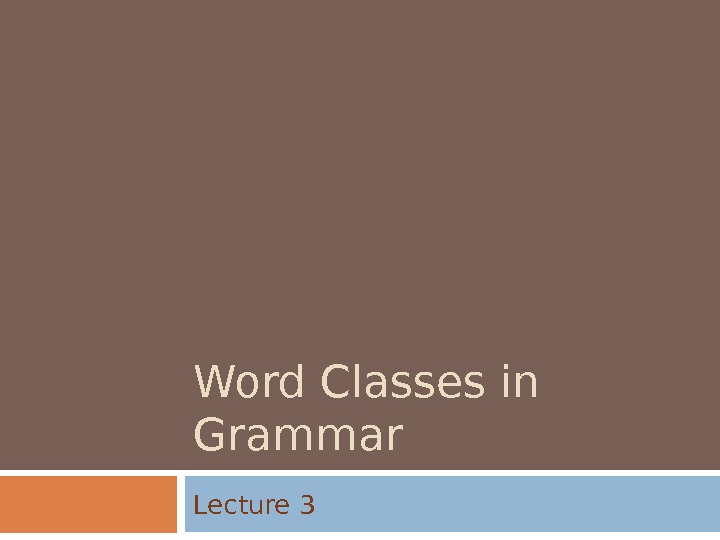





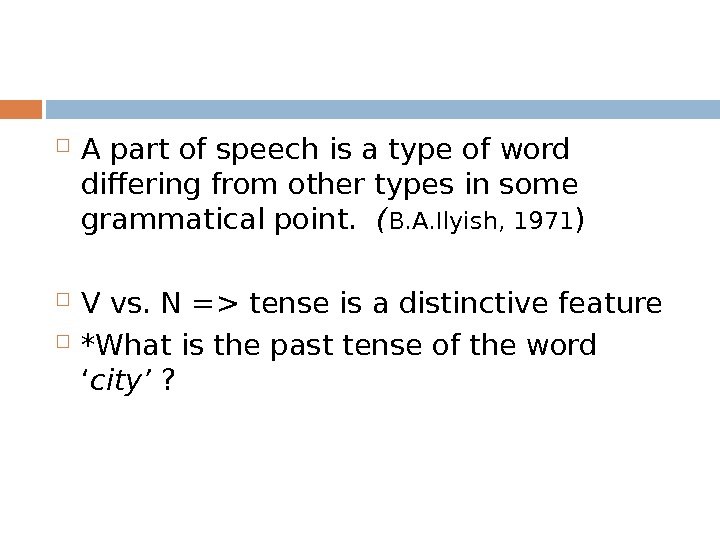
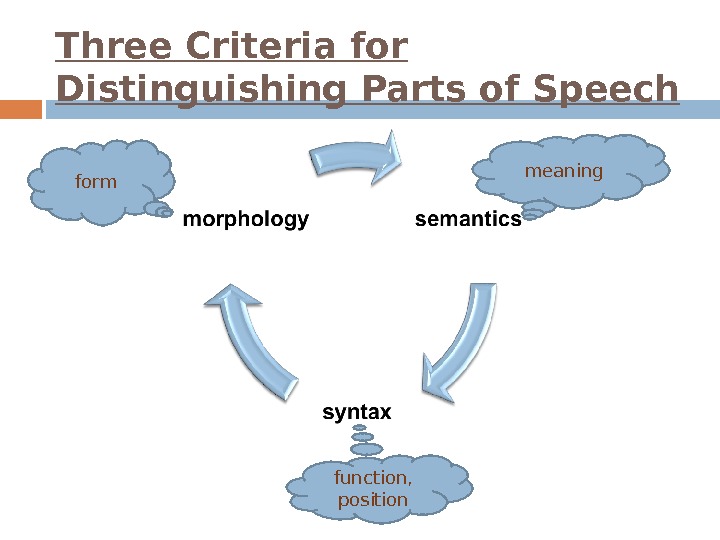


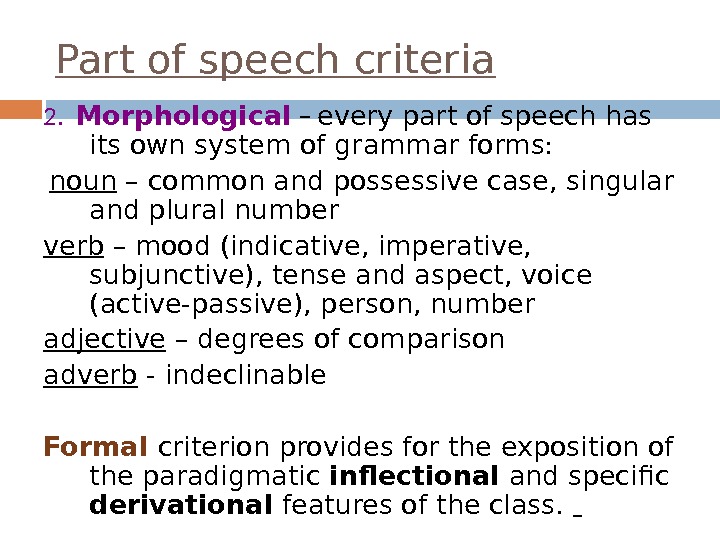
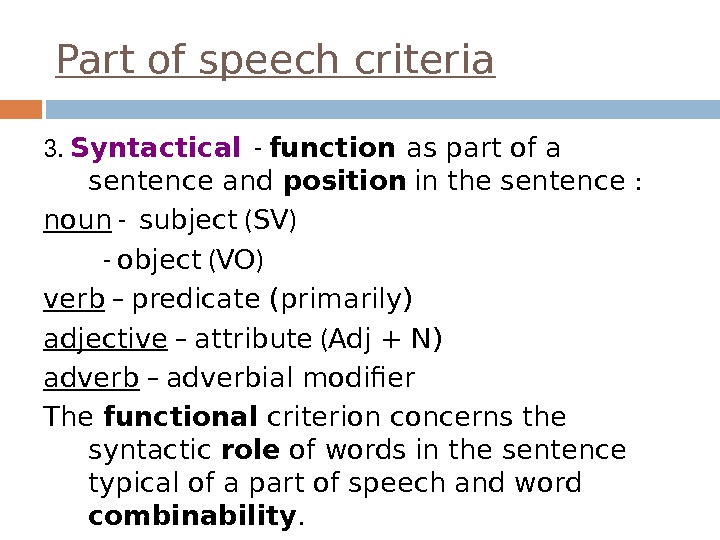
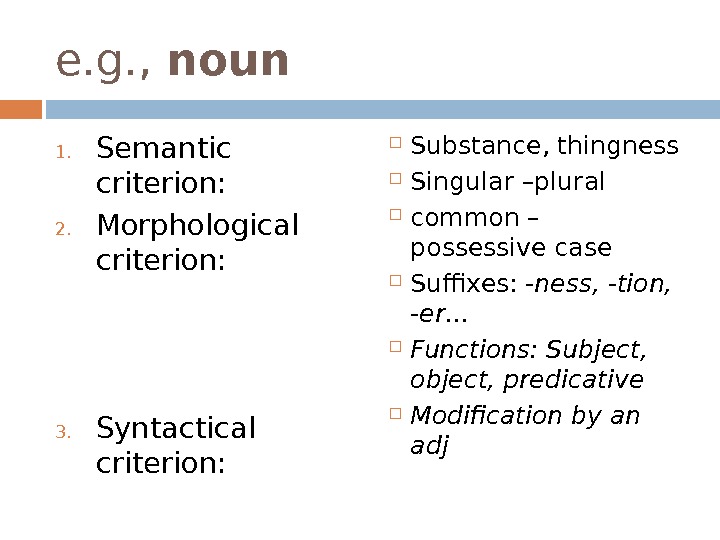

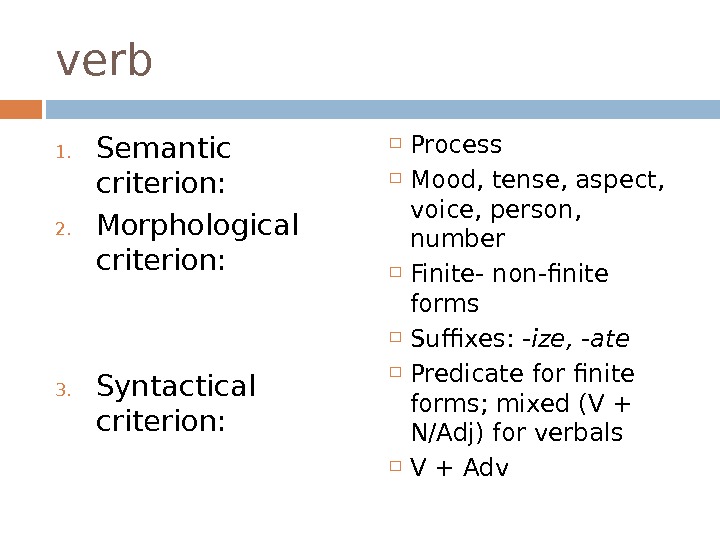

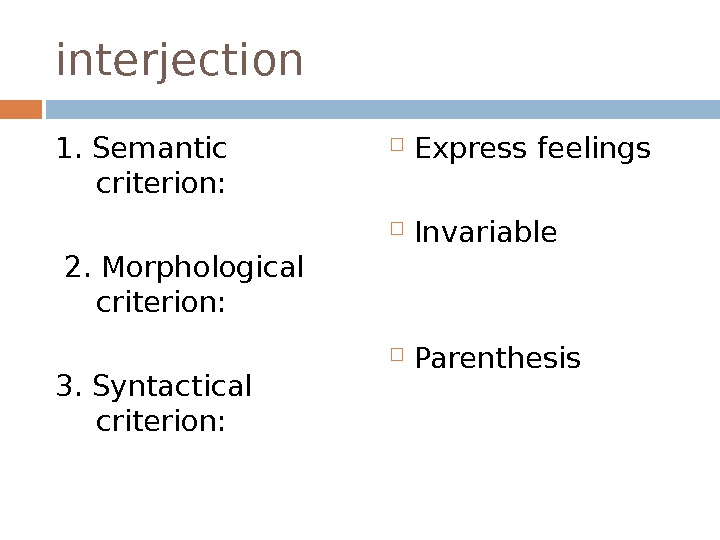

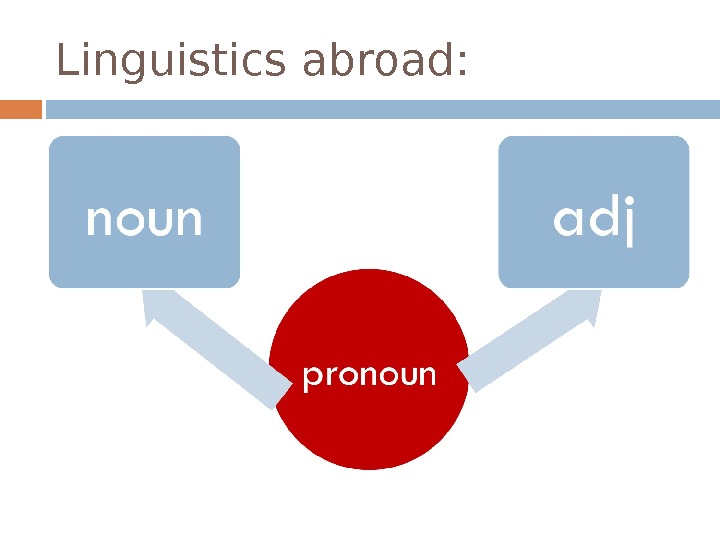
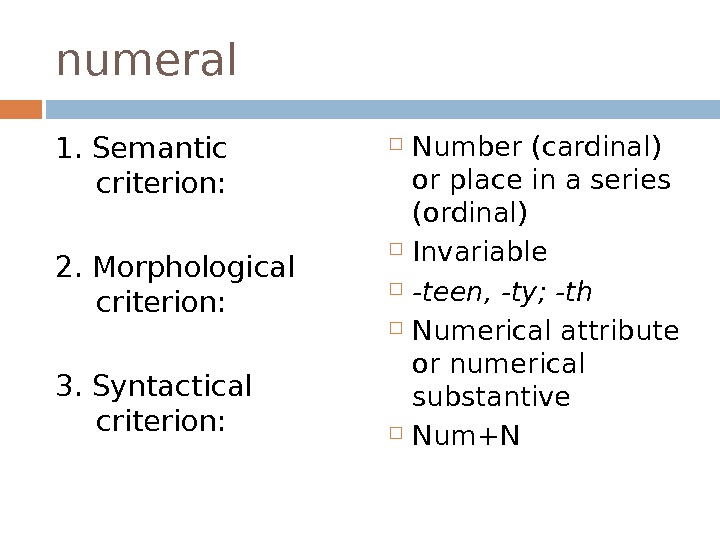
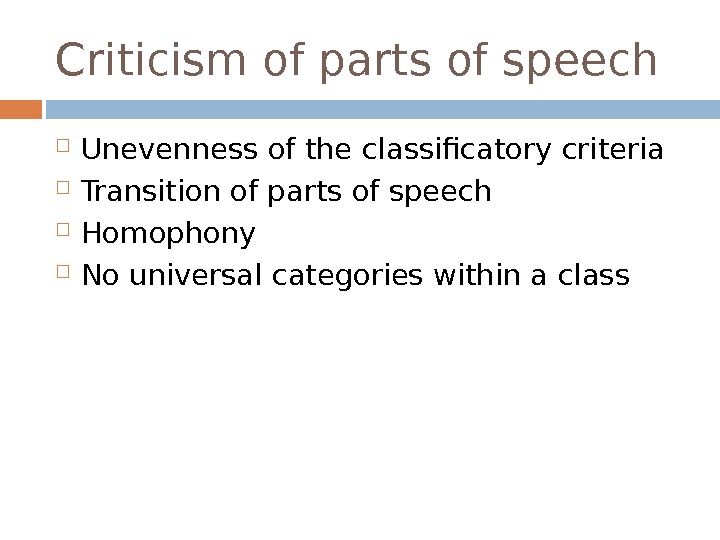
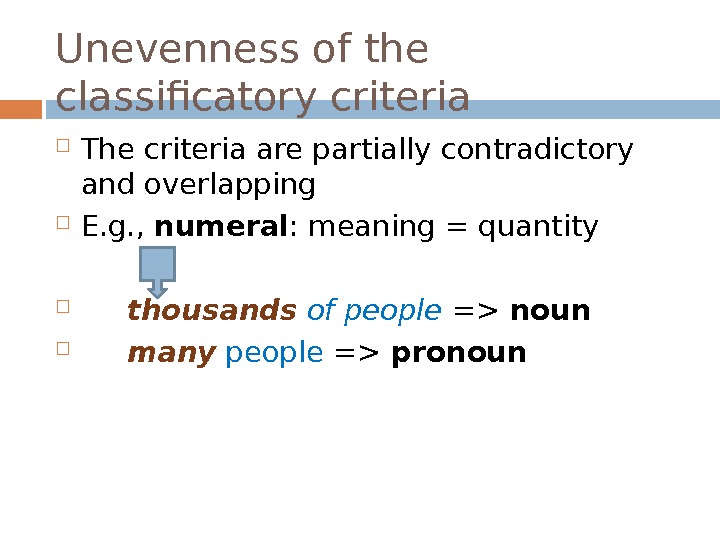



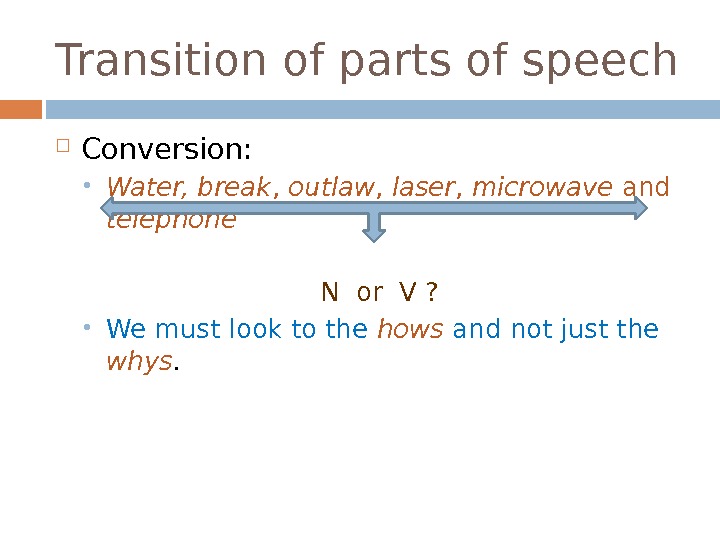

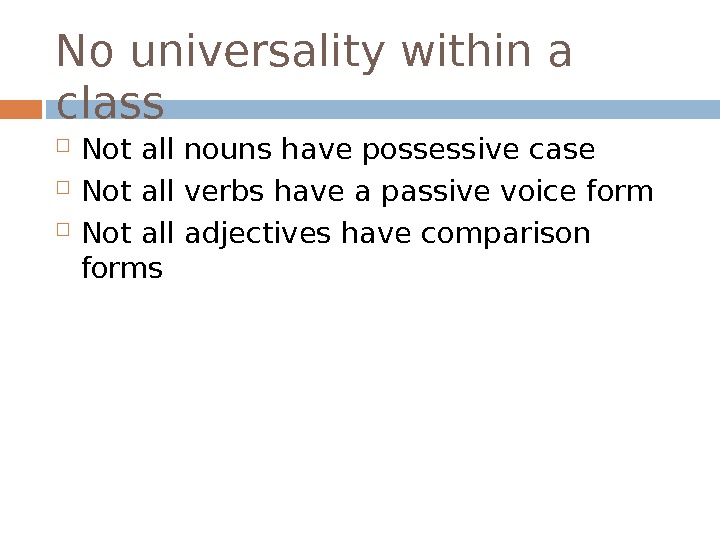

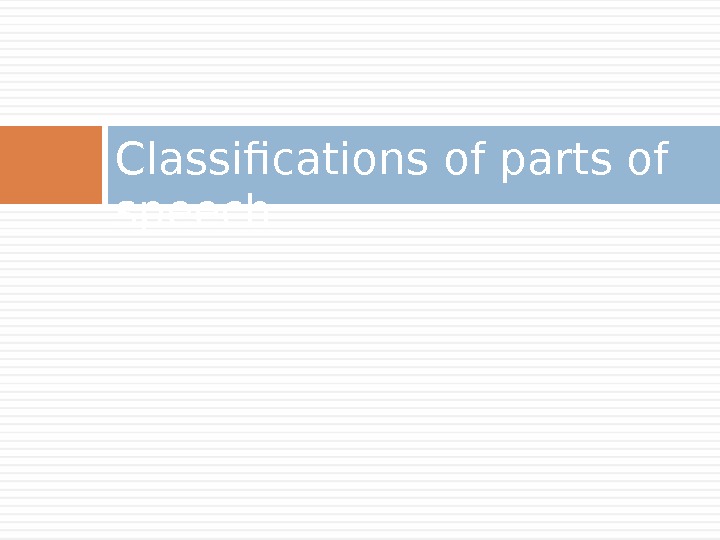

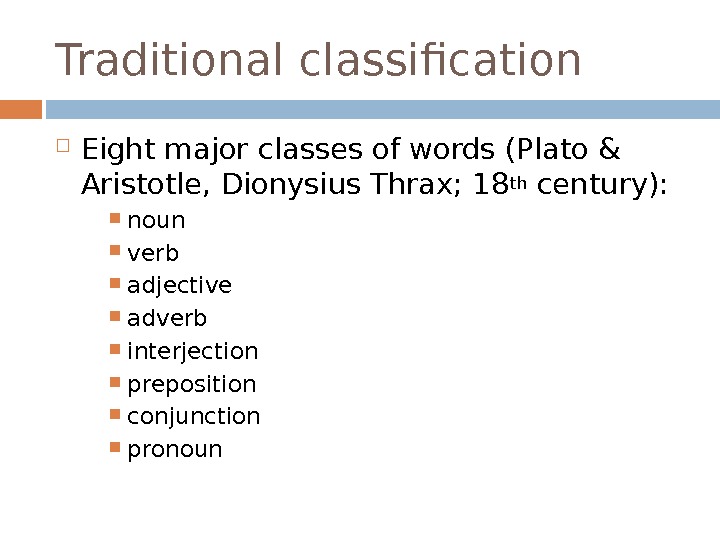




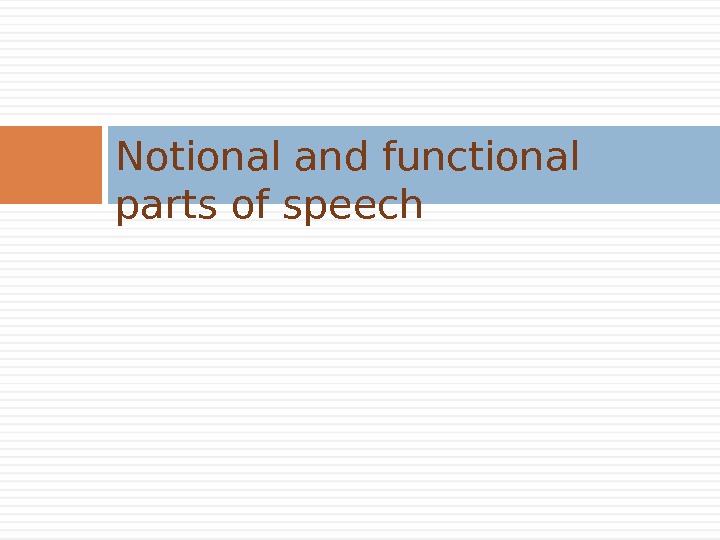
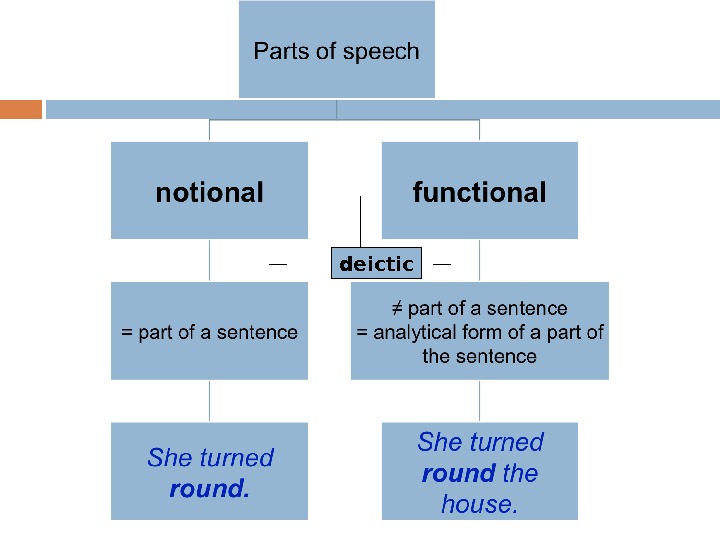
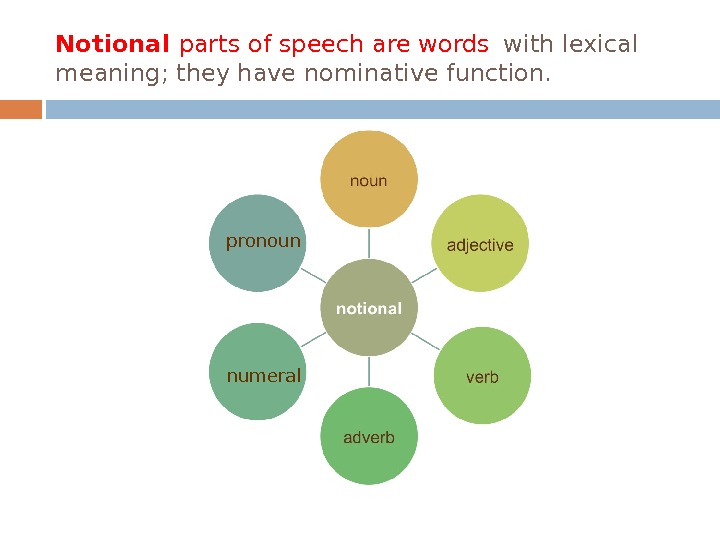


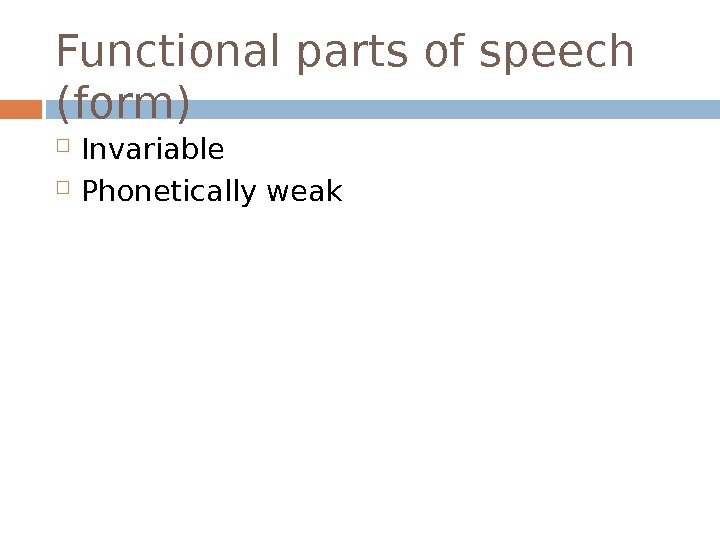


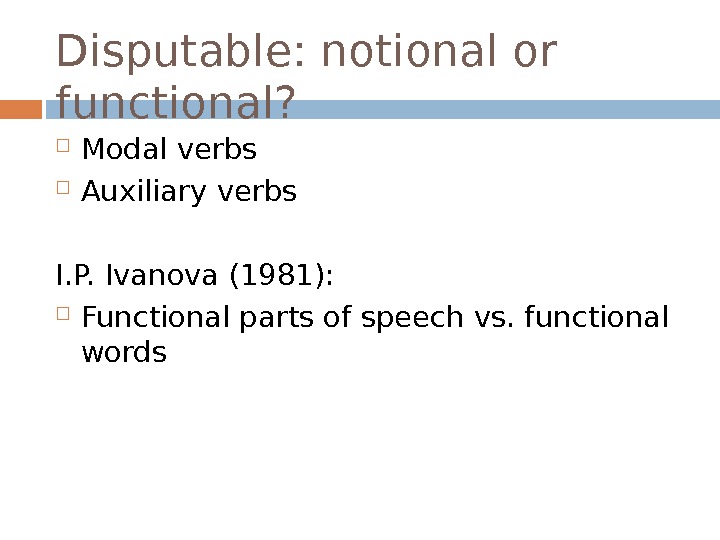



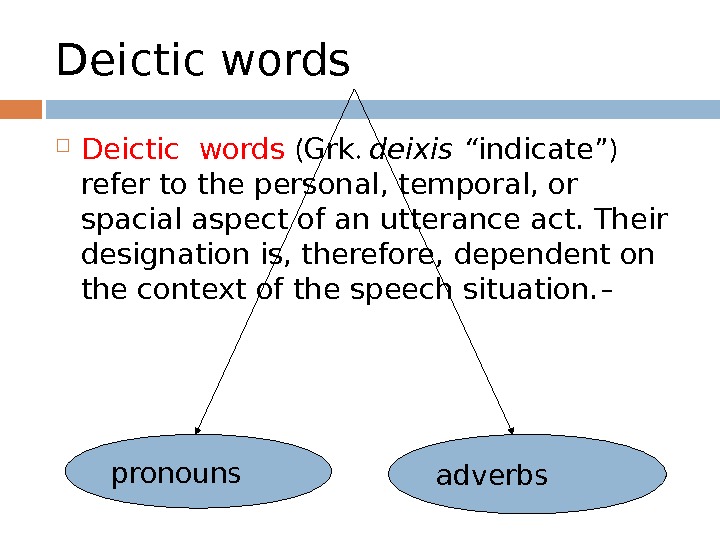




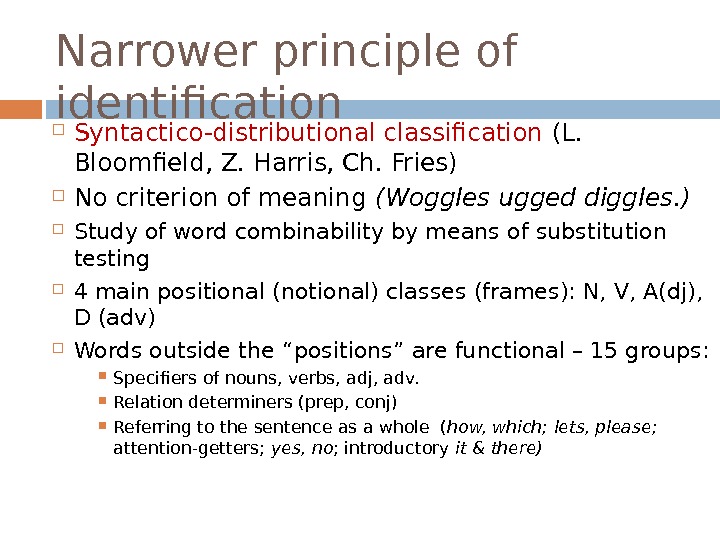


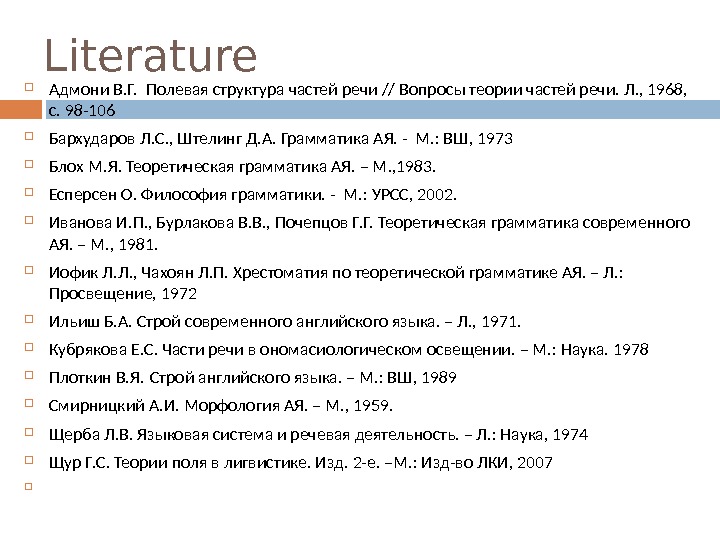
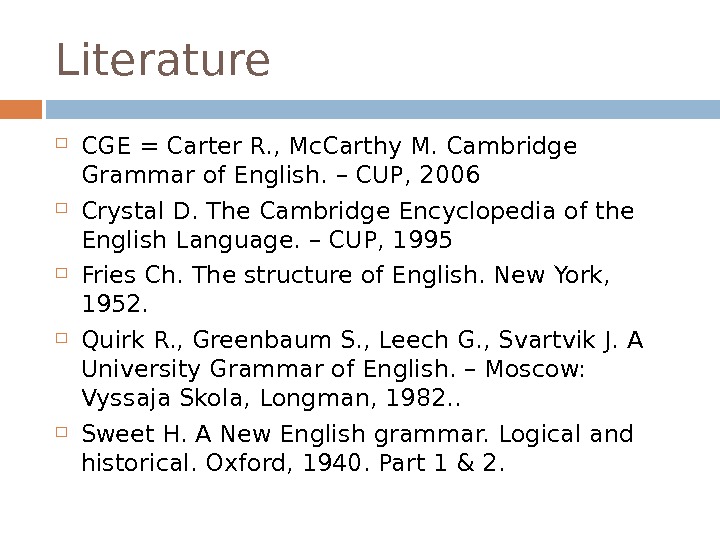
WORD STRUCTURE IN MODERN ENGLISH
I. The morphological structure of a word. Morphemes. Types of morphemes. Allomorphs.
II. Structural types of words.
III. Principles of morphemic analysis.
IV. Derivational level of analysis. Stems. Types of stems. Derivational types of words.
I. The morphological structure of a word. Morphemes. Types of Morphemes. Allomorphs.
There are two levels of approach to the study of word- structure: the level of morphemic analysis and the level of derivational or word-formation analysis.
Word is the principal and basic unit of the language system, the largest on the morphologic and the smallest on the syntactic plane of linguistic analysis.
It has been universally acknowledged that a great many words have a composite nature and are made up of morphemes, the basic units on the morphemic level, which are defined as the smallest indivisible two-facet language units.
The term morpheme is derived from Greek morphe “form ”+ -eme. The Greek suffix –eme has been adopted by linguistic to denote the smallest unit or the minimum distinctive feature.
The morpheme is the smallest meaningful unit of form. A form in these cases a recurring discrete unit of speech. Morphemes occur in speech only as constituent parts of words, not independently, although a word may consist of single morpheme. Even a cursory examination of the morphemic structure of English words reveals that they are composed of morphemes of different types: root-morphemes and affixational morphemes. Words that consist of a root and an affix are called derived words or derivatives and are produced by the process of word building known as affixation (or derivation).
The root-morpheme is the lexical nucleus of the word; it has a very general and abstract lexical meaning common to a set of semantically related words constituting one word-cluster, e.g. (to) teach, teacher, teaching. Besides the lexical meaning root-morphemes possess all other types of meaning proper to morphemes except the part-of-speech meaning which is not found in roots.
Affixational morphemes include inflectional affixes or inflections and derivational affixes. Inflections carry only grammatical meaning and are thus relevant only for the formation of word-forms. Derivational affixes are relevant for building various types of words. They are lexically always dependent on the root which they modify. They possess the same types of meaning as found in roots, but unlike root-morphemes most of them have the part-of-speech meaning which makes them structurally the important part of the word as they condition the lexico-grammatical class the word belongs to. Due to this component of their meaning the derivational affixes are classified into affixes building different parts of speech: nouns, verbs, adjectives or adverbs.
Roots and derivational affixes are generally easily distinguished and the difference between them is clearly felt as, e.g., in the words helpless, handy, blackness, Londoner, refill, etc.: the root-morphemes help-, hand-, black-, London-, fill-, are understood as the lexical centers of the words, and –less, -y, -ness, -er, re- are felt as morphemes dependent on these roots.
Distinction is also made of free and bound morphemes.
Free morphemes coincide with word-forms of independently functioning words. It is obvious that free morphemes can be found only among roots, so the morpheme boy- in the word boy is a free morpheme; in the word undesirable there is only one free morpheme desire-; the word pen-holder has two free morphemes pen- and hold-. It follows that bound morphemes are those that do not coincide with separate word- forms, consequently all derivational morphemes, such as –ness, -able, -er are bound. Root-morphemes may be both free and bound. The morphemes theor- in the words theory, theoretical, or horr- in the words horror, horrible, horrify; Angl- in Anglo-Saxon; Afr- in Afro-Asian are all bound roots as there are no identical word-forms.
It should also be noted that morphemes may have different phonemic shapes. In the word-cluster please , pleasing , pleasure , pleasant the phonemic shapes of the word stand in complementary distribution or in alternation with each other. All the representations of the given morpheme, that manifest alternation are called allomorphs/or morphemic variants/ of that morpheme.
The combining form allo- from Greek allos “other” is used in linguistic terminology to denote elements of a group whose members together consistute a structural unit of the language (allophones, allomorphs). Thus, for example, -ion/ -tion/ -sion/ -ation are the positional variants of the same suffix, they do not differ in meaning or function but show a slight difference in sound form depending on the final phoneme of the preceding stem. They are considered as variants of one and the same morpheme and called its allomorphs.
Allomorph is defined as a positional variant of a morpheme occurring in a specific environment and so characterized by complementary description.
Complementary distribution is said to take place, when two linguistic variants cannot appear in the same environment.
Different morphemes are characterized by contrastive distribution, i.e. if they occur in the same environment they signal different meanings. The suffixes –able and –ed, for instance, are different morphemes, not allomorphs, because adjectives in –able mean “ capable of beings”.
Allomorphs will also occur among prefixes. Their form then depends on the initials of the stem with which they will assimilate.
Two or more sound forms of a stem existing under conditions of complementary distribution may also be regarded as allomorphs, as, for instance, in long a: length n.
II. Structural types of words.
The morphological analysis of word- structure on the morphemic level aims at splitting the word into its constituent morphemes – the basic units at this level of analysis – and at determining their number and types. The four types (root words, derived words, compound, shortenings) represent the main structural types of Modern English words, and conversion, derivation and composition the most productive ways of word building.
According to the number of morphemes words can be classified into monomorphic and polymorphic. Monomorphic or root-words consist of only one root-morpheme, e.g. small, dog, make, give, etc. All polymorphic word fall into two subgroups: derived words and compound words – according to the number of root-morphemes they have. Derived words are composed of one root-morpheme and one or more derivational morphemes, e.g. acceptable, outdo, disagreeable, etc. Compound words are those which contain at least two root-morphemes, the number of derivational morphemes being insignificant. There can be both root- and derivational morphemes in compounds as in pen-holder, light-mindedness, or only root-morphemes as in lamp-shade, eye-ball, etc.
These structural types are not of equal importance. The clue to the correct understanding of their comparative value lies in a careful consideration of: 1)the importance of each type in the existing wordstock, and 2) their frequency value in actual speech. Frequency is by far the most important factor. According to the available word counts made in different parts of speech, we find that derived words numerically constitute the largest class of words in the existing wordstock; derived nouns comprise approximately 67% of the total number, adjectives about 86%, whereas compound nouns make about 15% and adjectives about 4%. Root words come to 18% in nouns, i.e. a trifle more than the number of compound words; adjectives root words come to approximately 12%.
But we cannot fail to perceive that root-words occupy a predominant place. In English, according to the recent frequency counts, about 60% of the total number of nouns and 62% of the total number of adjectives in current use are root-words. Of the total number of adjectives and nouns, derived words comprise about 38% and 37% respectively while compound words comprise an insignificant 2% in nouns and 0.2% in adjectives. Thus it is the root-words that constitute the foundation and the backbone of the vocabulary and that are of paramount importance in speech. It should also be mentioned that root words are characterized by a high degree of collocability and a complex variety of meanings in contrast with words of other structural types whose semantic structures are much poorer. Root- words also serve as parent forms for all types of derived and compound words.
III. Principles of morphemic analysis.
In most cases the morphemic structure of words is transparent enough and individual morphemes clearly stand out within the word. The segmentation of words is generally carried out according to the method of Immediate and Ultimate Constituents. This method is based on the binary principle, i.e. each stage of the procedure involves two components the word immediately breaks into. At each stage these two components are referred to as the Immediate Constituents. Each Immediate Constituent at the next stage of analysis is in turn broken into smaller meaningful elements. The analysis is completed when we arrive at constituents incapable of further division, i.e. morphemes. These are referred to Ultimate Constituents.
A synchronic morphological analysis is most effectively accomplished by the procedure known as the analysis into Immediate Constituents. ICs are the two meaningful parts forming a large linguistic unity.
The method is based on the fact that a word characterized by morphological divisibility is involved in certain structural correlations. To sum up: as we break the word we obtain at any level only ICs one of which is the stem of the given word. All the time the analysis is based on the patterns characteristic of the English vocabulary. As a pattern showing the interdependence of all the constituents segregated at various stages, we obtain the following formula:
un+ { [ ( gent- + -le ) + -man ] + -ly}
Breaking a word into its Immediate Constituents we observe in each cut the structural order of the constituents.
A diagram presenting the four cuts described looks as follows:
1. un- / gentlemanly
2. un- / gentleman / — ly
3. un- / gentle / — man / — ly
4. un- / gentl / — e / — man / — ly
A similar analysis on the word-formation level showing not only the morphemic constituents of the word but also the structural pattern on which it is built.
The analysis of word-structure at the morphemic level must proceed to the stage of Ultimate Constituents. For example, the noun friendliness is first segmented into the ICs: [frendlı-] recurring in the adjectives friendly-looking and friendly and [-nıs] found in a countless number of nouns, such as unhappiness, blackness, sameness, etc. the IC [-nıs] is at the same time an UC of the word, as it cannot be broken into any smaller elements possessing both sound-form and meaning. Any further division of –ness would give individual speech-sounds which denote nothing by themselves. The IC [frendlı-] is next broken into the ICs [-lı] and [frend-] which are both UCs of the word.
Morphemic analysis under the method of Ultimate Constituents may be carried out on the basis of two principles: the so-called root-principle and affix principle.
According to the affix principle the splitting of the word into its constituent morphemes is based on the identification of the affix within a set of words, e.g. the identification of the suffix –er leads to the segmentation of words singer, teacher, swimmer into the derivational morpheme – er and the roots teach- , sing-, drive-.
According to the root-principle, the segmentation of the word is based on the identification of the root-morpheme in a word-cluster, for example the identification of the root-morpheme agree- in the words agreeable, agreement, disagree.
As a rule, the application of these principles is sufficient for the morphemic segmentation of words.
However, the morphemic structure of words in a number of cases defies such analysis, as it is not always so transparent and simple as in the cases mentioned above. Sometimes not only the segmentation of words into morphemes, but the recognition of certain sound-clusters as morphemes become doubtful which naturally affects the classification of words. In words like retain, detain, contain or receive, deceive, conceive, perceive the sound-clusters [rı-], [dı-] seem to be singled quite easily, on the other hand, they undoubtedly have nothing in common with the phonetically identical prefixes re-, de- as found in words re-write, re-organize, de-organize, de-code. Moreover, neither the sound-cluster [rı-] or [dı-], nor the [-teın] or [-sı:v] possess any lexical or functional meaning of their own. Yet, these sound-clusters are felt as having a certain meaning because [rı-] distinguishes retain from detain and [-teın] distinguishes retain from receive.
It follows that all these sound-clusters have a differential and a certain distributional meaning as their order arrangement point to the affixal status of re-, de-, con-, per- and makes one understand —tain and –ceive as roots. The differential and distributional meanings seem to give sufficient ground to recognize these sound-clusters as morphemes, but as they lack lexical meaning of their own, they are set apart from all other types of morphemes and are known in linguistic literature as pseudo- morphemes. Pseudo- morphemes of the same kind are also encountered in words like rusty-fusty.
IV. Derivational level of analysis. Stems. Types of Stems. Derivational types of word.
The morphemic analysis of words only defines the constituent morphemes, determining their types and their meaning but does not reveal the hierarchy of the morphemes comprising the word. Words are no mere sum totals of morpheme, the latter reveal a definite, sometimes very complex interrelation. Morphemes are arranged according to certain rules, the arrangement differing in various types of words and particular groups within the same types. The pattern of morpheme arrangement underlies the classification of words into different types and enables one to understand how new words appear in the language. These relations within the word and the interrelations between different types and classes of words are known as derivative or word- formation relations.
The analysis of derivative relations aims at establishing a correlation between different types and the structural patterns words are built on. The basic unit at the derivational level is the stem.
The stem is defined as that part of the word which remains unchanged throughout its paradigm, thus the stem which appears in the paradigm (to) ask ( ), asks, asked, asking is ask-; thestem of the word singer ( ), singer’s, singers, singers’ is singer-. It is the stem of the word that takes the inflections which shape the word grammatically as one or another part of speech.
The structure of stems should be described in terms of IC’s analysis, which at this level aims at establishing the patterns of typical derivative relations within the stem and the derivative correlation between stems of different types.
There are three types of stems: simple, derived and compound.
Simple stems are semantically non-motivated and do not constitute a pattern on analogy with which new stems may be modeled. Simple stems are generally monomorphic and phonetically identical with the root morpheme. The derivational structure of stems does not always coincide with the result of morphemic analysis. Comparison proves that not all morphemes relevant at the morphemic level are relevant at the derivational level of analysis. It follows that bound morphemes and all types of pseudo- morphemes are irrelevant to the derivational structure of stems as they do not meet requirements of double opposition and derivative interrelations. So the stem of such words as retain, receive, horrible, pocket, motion, etc. should be regarded as simple, non- motivated stems.
Derived stems are built on stems of various structures though which they are motivated, i.e. derived stems are understood on the basis of the derivative relations between their IC’s and the correlated stems. The derived stems are mostly polymorphic in which case the segmentation results only in one IC that is itself a stem, the other IC being necessarily a derivational affix.
Derived stems are not necessarily polymorphic.
Compound stems are made up of two IC’s, both of which are themselves stems, for example match-box, driving-suit, pen-holder, etc. It is built by joining of two stems, one of which is simple, the other derived.
In more complex cases the result of the analysis at the two levels sometimes seems even to contracted one another.
The derivational types of words are classified according to the structure of their stems into simple, derived and compound words.
Derived words are those composed of one root- morpheme and one or more derivational morpheme.
Compound words contain at least two root- morphemes, the number of derivational morphemes being insignificant.
Derivational compound is a word formed by a simultaneous process of composition and derivational.
Compound words proper are formed by joining together stems of word already available in the language.
Теги:
Word structure in modern english
Реферат
Английский
Просмотров: 27506
Найти в Wikkipedia статьи с фразой: Word structure in modern english




